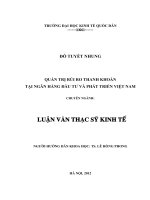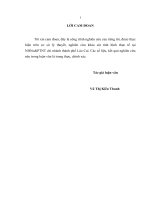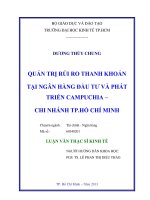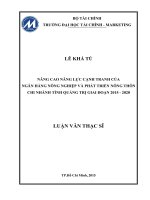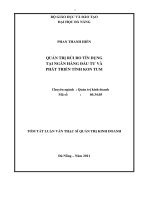Luận văn Thạc sĩ Kế hoạch phát triển chiến lược của ngân hàng đầu tư và phát triển BIDV giai đoạn 2015 2020
Bạn đang xem bản rút gọn của tài liệu. Xem và tải ngay bản đầy đủ của tài liệu tại đây (945.87 KB, 107 trang )
-1-
Luận văn thạc sĩ
Kế hoạch phát triển chiến lược của Ngân hàng đầu tư
và phát triển BIDV giai đoạn 2015-2020
THESIS MBA
PLANNING DEVELOPMENT STRATEGY FOR
BANK FOR INVESTMENT AND DEVELOPMENT
OF VIETNAM (BIDV), PERIOD 2010 – 2015
GRIGGS UNIVERSITY
GLOBAL ADVANCED MASTER OF BUSINESS ADMINISTRATION
PROGRAM
CAPSTONE PROJECT REPORT
Planning development strategy for Bank for Investment and
Development of Vietnam (BIDV), Period 2010 – 2015
ACKNOWLEDGEMENT
We would like to send our great thanks to teachers of VNU, who have taught
us with the enthusiasm and helped us have precious knowledge during the time of
studying the program. We also express our thanks to specialized team who have
read, given advices and instructed us during the study and completion of the project.
In addition, we would like to send our deep gratitude to the Bank for Investment
and Development of Vietnam, head office, Hanoi, Ha Thanh, Hung Yen branches
having helped and created favorable conditions so that we can obtain necessary
information for completing thesis.
3
TABLE OF CONTENTS
Contents
Pages
PREFACE
12
CHAPTER I.
14
FUNDAMENTALS OF STRATEGIC MANAGEMENT AND
STRATEGIC PLANNING IN ENTERPRISE
1.1. Definition and role of strategic management
14
1.1.1 Definition of strategic management
14
1.1.2. Role of strategic management
15
1.2. Definition and role of strategic planning
17
1.2.1 Definition of strategic planning
17
1.2.2. Role of strategic planning
17
1.3. Strategic planning process in enterprise
17
1.3.1. Defining strategic objective
18
1.3.2. Analyzing internal and external environment of the enterprise
19
1.3.3. Analyzing and selecting strategy
29
CHAPTER II.
ANALYSIS ON REAL SITUATION – ENVIRONMENT –
33
STRATEGY – BUSINESS OF BANK FOR INVESTMENT &
DEVELOPMENT OF VIETNAM
2.1. Overview about Bank for Investment and Development of VN
2.1.1.
General
information
about
Bank
Development of Vietnam
for
Investment
and
33
33
2.1.2. Functions and missions of BIDV
33
2.1.3. Business activities of BIDV
34
2.1.4. Organizational structure of BIDV
34
4
2.2. Analysis on business environment of BIDV
35
2.2.1. Macro-environment
35
2.2.2. Industry environment
43
2.2.3. Determining opportunities and threats
46
2.3. Analyzing the internal environment of BIDV
48
2.3.1. Administration
48
2.3.2. Marketing
51
2.3.3. Supply of Banking service and product
53
2.3.4. Human resources
57
2.3.5. Finance – Accounting
58
2.3.6. Communication system
62
2.4. Result of business activities
63
2.5. Analysis of strengths and weaknesses
68
2.5.1. Strengths
68
2.5.2. Weaknesses
69
CHAPTER III:
DEFINE THE DEVELOPMENT STRATEGY OF BANK FOR
INVESTMENT AND DEVELOPMENT OF VIETNAM FROM
72
2015-2020
3.1. Target, trend, mission and vision of BIDV
72
3.1.1. Governmental target and trend of Bank in general
72
3.1.2. Objectives, orientation and vision of BIDV
72
3.2. BIDV’s development strategy by 2015
77
3.2.1. Analysis of exploitation capacity of strengths
77
3.2.2. Analysis of capacity in limiting the weaknesses
77
3.2.3. Analysis of capacity of opportunity exploitation
78
5
3.2.4. Analysis of capacity in limiting the threats
78
3.3. Set up strategy by analyzing SWOT
78
3.3.1. Form SWOT matrix
78
3.3.2. Form the strategy in SWOT matrix
81
3.4. Strategic solutions
82
3.4.1 Healthy finance, profitability, financial status enhancement, risk
reserve and indicator assurance
3.4.2. Restructuring organization and management, as well as
improving administration capability
82
85
3.4.3. Develop service product and modernize banking technology
87
3.5. Functional strategy
90
3.5.1. Develop retailed banking service
90
3.5.2. Continue increasing quality in business of subsidiaries
92
3.5.3. Expand Services
94
3.5.4. Develop Trade mark
95
3.5.5. Network organization model and distribution
95
3.5.6. Competition for Integration
95
3.6. Key factors ensure the success of plan
95
3.7. Factors to facilitate the implementation of plan need to be
improved
CONCLUSION
96
97
6
ABBREVIATED TERMS
Abbreviated
English
Vietnamese
word
WTO
World Trade Organization
Tổ chức thương mại thế giới
DN
Enterprise
Doanh Nghiệp
NH
Bank
Ngân Hàng
ĐTCT
Competitor
Đối Thủ Cạnh Tranh
TMCP
Joint stock commerce
Thương Mại Cổ Phần
R&D
Research and Development
Nghiên cứu và phát triển
SBU
Strategic Business Unit
Đơn vị kinh doanh chiến lược
HĐQT
Board of Management
Hội Đồng Quản Trị
Association of Southeast
Hiệp hội các quốc gia Đông Nam Á
ASEAN
Asian Nations
Bank for Investment and
Ngân hàng Đầu tư và Phát triển Việt
Development of Vietnam
Nam
NHNN
State Bank of Vietnam
Ngân Hàng Nhà Nước
DPRR
Reserve Ricks
Dự phòng rủi ro
BIDV
LIST OF FIGURES, TABLES AND CHARTS
7
Page
Figures
Figure 1.1: Five tasks of strategic management
16
Figure 1.2: Strategic planning process in enterprise
18
23
Figure 1.4: Five competitive forces of Michael.E.Porter
24
Figure 1.5: Value chain
28
31
Figure 2.1: Comparing the capital mobilization of BIDV with that of
other banks
Figure 2.2: BIDV’s Value chain
43
68
8
Charts
Page
Chart 2.1: GDP growth and GDP per capita in 1998-2007
36
Chart 2.2 : Interest rate change in 2008
37
Chart 2.3 : Prime interest rate of State Bank in the last months of
2008
38
Chart 2.4: Exchange rate of Vietnam dong over USD in 2003-2008
39
Chart 2.5: Inflation in the period of 1995-2007
40
46
9
Page
Tables
Table 2.1: Number of branches of BIDV to be regionally
allocated in 2007
51
Table 2.2: Credit quality
59
Table 2.3: Stockholder’s equity (IFRS)
61
Table 2.4: List of internal and external factors of BIDV
63
Table 2.5: Operating results
64
Table 2.6: Income structure for phase 2005 – 2010
65
Table 2.7: Market share of BIDV
69
Table 2.8: Targets of strategy performance in phase 2005-2010
70
Table 3.1: SWOT matrix of BIDV
79
PREFACE
10
A. Reason for choosing the Subject:
Business strategy is always one of the important factors affecting the survival
and development of an enterprise. Especially in a period when the competitiveness
and economic crisis is as critical as now, the future of an enterprise more and more
depends on whether that enterprise has a good business strategy or not. On the other
hand, besides Vietnam become a member of the World Trade Organization (WTO),
our enterprises are facing with new challenges; the competitiveness is not only
among domestic enterprises but also among foreign ones.
In fact, after Vietnam become a WTO official member, governments of many
countries and their banks also put pressure on Vietnam aimed at operating in
Vietnam market, particularly the foreign banks which meet regulations specified in
the Banking Law and strategy of developing Vietnam market. On the other hand,
Vietnamese Banks do not receive protection from the State any more, thus, there is
no difference between domestic or foreign banks. Up to now, the two banks: Bank
for Foreign Trade of Vietnam and Vietnam Bank for Industry and Trade have been
capitalized, and other trade banks of the State will be capitalized in near future;
therefore, pressure on sharing profits to shareholders is not little if business
operation and investment of the bank is ineffective. Besides, brain drain of the State
Bank to highly-profitable foreign banks is also remarkable issue. With powerful
financial capacity, foreign banks shall find any way including propaganda,
promotion and reduction of service price to create prestige and control the market.
For above reasons, our group including four members has chosen the research
subject “Planning development strategy with the Bank for Investment and
Development of Vietnam in the period 2015-2020” and hopes to contribute an
tiny effort aimed at providing banks in Vietnam in general and the Bank for
Investment and Development of Vietnam in particular with the overview on
banking market so that they can build the most suitable business strategy in the
coming time.
11
B. Objective of the Study
Our thesis aims at studying operating environment of the Bank for Investment
and Development of Vietnam including factors inside and outside the bank. Thanks
to that, it is possible to define good opportunities, risks and development orientation
for the bank in the period 2010 - 2015, also help the bank keep its competitive
advantage in the market and develop more in the integration period.
C. Object and scope of the study
Object and scope of our study is the Bank for Investment and Development of
Vietnam and Banking industry in Vietnam, respectively.
D. Studying method
In order to complete the thesis, various studying methods have been used by
our group including statistics, analytical method, method of consulting experts,
observation and interview, etc.
E. Structure of the Thesis
Besides the overview, conclusion, table of contents, and references, the thesis
is divided into three parts.
Chapter I: Overview of strategic management and strategy planning in
an enterprise.
Chapter II: Analyzing internal and external environment of the Bank for
Investment and Development of Vietnam.
Chapter III: Strategy planning with the Bank for Investment and
Development of Vietnam in the period 2010 - 2015.
CHAPTER I.
FUNDAMENTALS OF STRATEGIC MANAGEMENT AND
STRATEGIC PLANNING IN ENTERPRISE
12
1.1. Definition and role of strategic management
1.1.1 Definition
The term Strategy comes from two Greek words “stratos” (meaning an army)
and “agos” (meaning to lead, to guide to move) referring to large and long-term
plans on the basis of analyzing strengths and weaknesses of opponents, first of all, it
is used in military. Since then, the term business strategy is used, in traditional
viewpoint; strategy is the determination of basic long-term goals and objectives of
an organization to give out specific action plan as well as use resources properly to
achieve the planned objectives.
According to Alfred Chandler1: “Strategy is the determination of basic longterm goals and objectives of an enterprise, and the adoption of courses of action and
the allocation of resources necessary for carrying out these goals”.
According to William J’. Glueck2, strategy is “a unified, comprehensive and
integrated plan designed to assure that the basic objectives of the enterprise are
achieved”.
Fred R. David3 defined strategy as “Means by which annual objectives will be
achieved. Business strategy may include geographic expansion, diversification,
acquisition, product development, market penetration, retrenchment, divestiture,
liquidation and joint venture”.
Michael E. Porter4 stated strategy as “Positioning the company so that its
capabilities provide the best defense against the competitive forces”.
Together with definition of business strategy, strategic management is also
introduced.
1
Nguyen Khoa Khoi and Dong Thi Thanh Phuong (2007), Strategic management, Statistics Publisher, p.4.
Nguyen Khoa Khoi and Dong Thi Thanh Phuong (2007), Strategic management, Statistics Publisher, p.4.
3
Fred David (2006), Translation version: Strategic management Concepts, Statistics Publisher, p. 20.
4
Assoc. Prof. Dr. Dong Thi Thanh Phuong, MA. Nguyen Dinh Hoa, MA. Tran Thi Y Nhi (2005), Textbook
of Strategic management, Statistics Publisher, p. 26.
2
13
Fred R. David5 defined strategic management as: “Art and science of
formulating, implementing, and evaluating cross-functional decisions that enable an
organization to achieve its objectives”.
John Pearce II and Richard B. Robinson6 defined strategic management: “as
the set of decisions and actions that result in the formulation and implementation of
plans designed to achieve a company’s objectives”.
Thus, like any management progress, strategic management includes planning,
organization, implementation and supervision of implementation. Management
object here is the environmental impacts (opportunities, mishaps) and the way
which enterprises respond environmental impacts (by efforts of all sections in
enterprise). In other words, strategic management comprises general planning
activities, implementation, supervision and adjustment of strategic management in
order to ensure that enterprise always takes full advantage of all opportunities,
chances as well as limiting or avoiding threats, risks on the way of implementing its
objectives.
1.1.2. Role
Strategic management helps enterprise orient clearly strategic visions,
missions, and its objectives, or otherwise helps enterprise realize its objective and
direction to select the way to achieve objectives proposed at the same time strategic
management shows the position of enterprise in implementing these objectives.
Strategic management helps enterprise recognize opportunities, risks from
external environment, strengths, weaknesses in current enterprise to promote strong
point and minimize weaknesses in order to take advantage of opportunities and have
solutions to prevent from threats outside, helping enterprise in choosing the best
strategy suitable with environment and business situation. This is very important
especially in more and more complicated, continuously changed and critical
environment all over the world.
5
Fred David (2006), Translation version: Strategic management Concepts, Statistics Publisher, p. 9.
Assoc. Prof. Dr. Dong Thi Thanh Phuong, MA. Nguyen Dinh Hoa, MA. Tran Thi Y Nhi (2005), Textbook
of Strategic management, Statistics Publisher, p. 26.
6
14
Strategic management requires managers to update information on internal
and external environment of enterprise, thanks to this, predict and plan possible
situations. Therefore, it also helps company always make decision actively and
flexibly to cope with the changes of market.
Figure 1.1: Five tasks of strategic management7
Develop
strategic
prospect
and
mission
Repair if
necessary
Establish
objective
Repair if
necessary
Build
strategies
to achieve
objectives
Improve/
change if
necessary
Perform
and run
selected
strategies
Improve/
change if
necessary
Assess
performance,
repair and
adjust
Restore
1,2,3,4
if necessary
1.2. Definition and role of strategic planning
1.2.1 Definition
Planning is one of the most significant and basic operations of managers. The
term planning is generally construed as drafting and completing ideas and projects.
Strategic planning is the determination of objectives of organization, construction of
general planning to achieve proposed objective and development of a
comprehensive planning system to coordinate and combine with operations of
organization. In accompanying with the development of organization, strategic
7
Assoc. Prof. Dr. Le The Gioi, Dr. Nguyen Thanh Liem, MA. Tran Huu Hai (2007), Strategic management,
Statistics Publisher, p. 12.
15
planning plays a more and more important role. It is the spine controlling all
operations as well as culture of an organization.
1.2.2. Role
Strategic planning is an important stage in strategic management process; it
orients managers as well as execution staffs. When staffs define where their
organizations go and what they have to contribute in order to reach organization’s
objective, they will coordinate to gain the highest efficiency, avoid repetition and
waste resources.
Strategic planning also contributes to limiting instability because it forces
managers to have broad view, predict possible change, assess impact of those
changes and prepare plan suitable with those changes.
Strategic planning sets up strategic objectives which are also just standards for
control activities. By planning, it is easier to recognize weak activities to have
timely repair, make enterprise have more and more complete operation machinery.
1.3. Strategic planning process in enterprise
Strategic planning process in enterprise includes the following steps: First of
all, enterprise has to define their objectives in given time, after that, analyze
external environment to determine chances and challenges, and then, analyze
internal environment to define strength and weakness of enterprise in order to
analyze and select reasonable strategies.
Figure 1.2: Strategic planning process in enterprise
16
1.3.1. Defining strategic objective
Each organization needs define one own specific mission (task). Mission is
read as the reason for existence and operation of company, answer to question
“What must we do?”; “Why do we do business?”
In terms of company’s tasks, product, market, customer, technology, profit,
community image, staff and business philosophy are usually mentioned. In order to
define these missions, company needs find out the answer to the following question:
1. Customer: Who is company’s customer?
2. Product or service: What is the main product and service of company?
3. Market: Which market does company focus on?
4. Technology: Does company pay attention to technology development?
5. Attention to existence, growth and profit: Does company undertake to gain
financial stabilization and growth?
6. Business philosophy: What are the recognized key values, basic beliefs,
aspiration and priorities in terms of business ethics of company?
7. Self-assessment: What is the competitive benefit and special capacity of the
company?
8. Attention to image before community: How does company meet demand for
social and environmental issues?
17
9. Attention to staff: Does company consider its staff as valuable asset?
From mission and vision of company, leaders will define strategic objectives
of that company. Strategic objective states the specific results which company
wants to gain in a given time. Defining strategic objective is specialization of
company mission into specific tasks as well as giving orientation for management
decision and forming standard to evaluate work achievement.
Two basic strategic objectives of enterprise are financial and strategic. The
former refers to improving financial and the latter aims at competitive position of
company in industry. In the process of implementing long-term strategic objectives,
enterprise can divide into many short-term objectives respective with each period.
1.3.2. Analyzing business internal and external environment of the enterprise
1.3.2.1. Analyzing external enterprise (EFE)
The assessment of external environment shows us major opportunities and
risks and enables the enterprise to plan strategy taking advantage of opportunities
and avoiding threats. External environment is divided into macro-environment and
industry environment.
Analyzing macro-environment
Analyzing macro environment through the following factors:
Economic factors:
Gross Domestic Product (GDP): Enable us
to have an overview of economy health, impact
indirectly on business activities of industries in
economy, as well as being lever to boost
operation process of enterprise.
Income per capita: Increase income per
capita will lead to increase in demand, quantity,
and quality of goods, make customer’s taste change.
Inflation factor, foreign exchange rate, fiscal policy also influences
18
business strategy of enterprise.
In terms of government, politics and law:
Enterprise must comply with regulations of the government and law so the
regulations on tax, safety and environmental protection, import-export policies,
industrial ownership protection and socio-political stabilization and so on also
impact on enterprise’s strategy.
Social factors:
Consumption characteristics, life style or culture of each region, locality will
take effect on taste, demand of customer there in terms of variety, model and quality
of goods.
Population increase speed impacts directly on amount of demand, increases
goods consumption market, thus influences positively enterprise’s strategy.
Natural factor:
Environmental pollution, natural resources waste and especially natural
calamity, flood affect input material, production process and product consumption
market of enterprise, thus make enterprise’s strategy impact.
Technological factor:
More and more new, advanced technology
invention also creates chances as well as risks for
enterprise.
New invented technology is the
chance for enterprise to take advantage to
manufacture products with high competitiveness
and the risk if other enterprises apply before. At the same time, new technology
creates new better products, makes existing products become backwardness or
reduces life cycle of product.
Analyzing industry environment
Analysis of industry environment or micro-environment is the consideration of
emergence factor in operation industry deciding property and competitive level in
19
this industry. This is also called competitive environment because it links directly to
each enterprise and most competitive activities of enterprise in this environment.
Three main tools are used to analyze industry environment, i.e. strategic group,
development cycle of industry and five competitive forces of Michael E.Porter.
• Strategic group
Strategic group is a group of companies applying one same or similar strategy
in one certain target market. Determining to which strategic group enterprise is
belonging will help strategic planners narrow sphere of main competitors with
which enterprise must cope. Different strategic groups will create various barriers to
entry industry.
• Model of five competitive forces
Michael E. Porter, Harvard Professor, proposed one framework to help
managers recognize opportunities and risks with which enterprise must deal in one
industry. This framework is called “The five competitive forces that shape strategy”
as Figure 1.4.
Figure 1.4: Model of five competitive forces of Michael.E.Porter8
8
Garry D. Smith, Danny R. Arnold, Boby R. Bizzell, Translator: Bui Van Dong (2003),
Business strategy and policy, Statistics Publisher
20
Risks of reducing market share from new competitors (Potential
entrants):
When potential entrants take part in industry, market share, profit of enterprise
will reduce. To maintain its competitive position, enterprise must increase barrier to
entry industry through solutions such as product diversification, scale advantage, etc
or access to distribution. Moreover, policies of the government, intellectual property
right, or accessibility to material resources also create barrier to entry industry of
potential entrants.
Bargaining power of suppliers:
Suppliers are enterprises supplying input factors for operation of enterprise.
Relative forces of suppliers are usually shown in the following cases:
• When there are only a few suppliers.
• When substitutes are not available.
21
• When products of supplier are important input factors for operations
of customers, etc
Bargaining power of customers (buyers):
Customer’s prestige is valuable assets for enterprise. However, when
customers predominate, they can reduce enterprise’s profit by bargaining or
requiring higher quality. Pressure from customers originates from the following
conditions:
• When the number of customers is small:
• When customers buy a large and concentrative volume
• When product of enterprise is common product without high
differentiation
• When customers threaten and have capability of integrating backward.
• When customers have lots of information.
Threats of substitute products or service :
Substitute products are products meeting one demand of customers such as
product of enterprise. Substitute products can put pressure on competitive
enterprises in terms of price, quality of products-services, function – performance of
products, model of new product, new consumption trend.
Industry competitors:
Existing competitors is enterprises currently operating in one operation
industry. Analyzing existing competitors helps enterprises define competitive level
between enterprises in the same industry. There are three main factors impacting on
competitive level between enterprises in the same industry, i.e. industry structure,
demand and industry exit barriers.
• Industry structure
22
Industry structure is distribution in terms of number of enterprises with
various scales in the same business and production industry. Generally, in
decentralized industries include a large number of small and medium-size
enterprises operating individually and independently, competitive level will be
fiercer, there is no enterprise playing the dominant role of the whole industry and
competition in prices arises easily. In contrast, the centralized industry includes a
small number of enterprises, most large-size ones and even one dominant enterprise
of the whole industry, competitive level in these industries is not fierce as
decentralized industries but difficult to analyze and predict.
• Industry demand
If the demand of industry increases, enterprise will have the chance of
increasing revenue, reaching higher growth rate. However, if demand increases too
high, it means that industry becomes more and more attractive and lots of
enterprises want to take part in the industry. That would be risk for enterprises
currently operating in the industry. In contrast, decrease in industry demand will
make competitive amongst enterprises fiercer. It is difficult for enterprises without
competitive capacity to avoid threats of market loss.
• Industry exit barrier
When operating in one industry is not advantageous any more, due to
subjective and objective reasons, enterprises in the industry want to move into
other business line. Sometimes, it is hard to leave because enterprise must
overcome some specific barriers. The industry exit barriers usually include:
♦ Investment expense and other expenses: fixed assets, training
expense, advertising expenses, expenses for building distribution channel, etc.
♦
Relationship between business activities of enterprise: if enterprise
takes part in operation of various business lines, industry exit will impact
largely on general strategy of enterprise. If the impact is too large, it is
difficult for enterprise to exit one industry.
23
♦ Psychological factor: value, prestige of leaders
♦ Legal ties are also one barrier restricting industry exit. When
enterprise wants to exit a certain industry that enterprise must carry out many
administrative procedures in that industry and other procedures to join one
another industry. Administrative procedures are complicated, cost enterprise a
lot of time and effort.
From analyzing factors of external environment, enterprise will recognize
opportunities and potential risks. Opportunities will be levers helping enterprise
develop but risks damage existence and development of enterprise.
1.3.2.2. Analyzing internal enterprise (IFE)
Analyzing internal enterprise is to find out strengths and weaknesses of
enterprise in order to define distinguishing capacities of enterprise in industry.This
is the basis for enterprise to build suitable business strategy.
It focuses on analyzing functional activities such as: production, marketing,
R&D, human resources, accounting finance, organization order and discipline, etc.
In order to assess operation situation of functional parts in enterprise correctly,
managers need analyze functional parts in its movement process, that means
analysis of these factors in context that operation activities is in “value chain” of
enterprise.
Value chain is the systematic related activities of enterprise to increase value
for customers. Value chain includes two main operation groups: main activities and
supplementary ones.
Figure 1.5: Value chain
24
Input
Supply
Activities
• Main activities: directly impact on value of the product and services
(creating value) including input activities, production, output activities, marketing
and sale, service.
Input activities: being in association with activities of receiving,
reserving, and managing input factors. The completion of any activity among
these shall result in reduction of cost and increase of productivity.
Product: includes all activities aimed at changing input into final
product.
Output activities: are activities delivering finished products to
enterprises’ customers. These activities include storage, management of
products, delivery of goods and orders processing.
Marketing and sale: relating to products, price, promotion and
support, distribution channel.
Service: Customer services include activities such as installation,
repair, consultancy, supply of component, parts, adjustment of products as
well as patience to satisfy customers’ claim and requirement. Customer
service is higher and higher appreciated and considered as one of the most
important activities of the enterprise.
• Supporting activities: are activities affecting indirectly product and
service value (adding more value).
Infrastructure of the enterprise:
25
